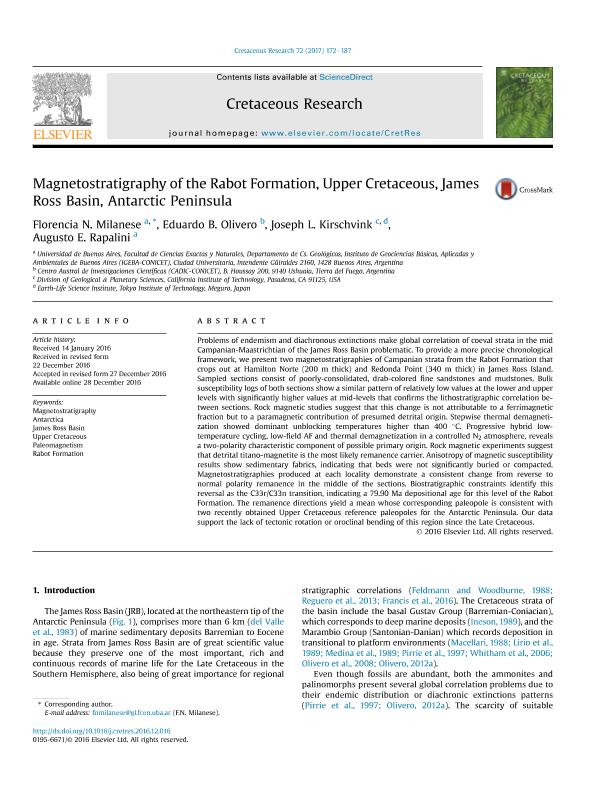Artículo
Magnetostratigraphy of the Rabot Formation, Upper Cretaceous, James Ross Basin, Antarctic Peninsula
Milanese, Florencia Nidia ; Olivero, Eduardo Bernardo
; Olivero, Eduardo Bernardo ; Kirschvink, Joseph L.; Rapalini, Augusto Ernesto
; Kirschvink, Joseph L.; Rapalini, Augusto Ernesto
 ; Olivero, Eduardo Bernardo
; Olivero, Eduardo Bernardo ; Kirschvink, Joseph L.; Rapalini, Augusto Ernesto
; Kirschvink, Joseph L.; Rapalini, Augusto Ernesto
Fecha de publicación:
04/2017
Editorial:
Academic Press Ltd - Elsevier Science Ltd
Revista:
Cretaceous Research
ISSN:
0195-6671
Idioma:
Inglés
Tipo de recurso:
Artículo publicado
Clasificación temática:
Resumen
Problems of endemism and diachronous extinctions make global correlation of coeval strata in the mid Campanian-Maastrichtian of the James Ross Basin problematic. To provide a more precise chronological framework, we present two magnetostratigraphies of Campanian strata from the Rabot Formation that crops out at Hamilton Norte (200 m thick) and Redonda Point (340 m thick) in James Ross Island. Sampled sections consist of poorly-consolidated, drab-colored fine sandstones and mudstones. Bulk susceptibility logs of both sections show a similar pattern of relatively low values at the lower and upper levels with significantly higher values at mid-levels that confirms the lithostratigraphic correlation between sections. Rock magnetic studies suggest that this change is not attributable to a ferrimagnetic fraction but to a paramagnetic contribution of presumed detrital origin. Stepwise thermal demagnetization showed dominant unblocking temperatures higher than 400 °C. Progressive hybrid low-temperature cycling, low-field AF and thermal demagnetization in a controlled N2 atmosphere, reveals a two-polarity characteristic component of possible primary origin. Rock magnetic experiments suggest that detrital titano-magnetite is the most likely remanence carrier. Anisotropy of magnetic susceptibility results show sedimentary fabrics, indicating that beds were not significantly buried or compacted. Magnetostratigraphies produced at each locality demonstrate a consistent change from reverse to normal polarity remanence in the middle of the sections. Biostratigraphic constraints identify this reversal as the C33r/C33n transition, indicating a 79.90 Ma depositional age for this level of the Rabot Formation. The remanence directions yield a mean whose corresponding paleopole is consistent with two recently obtained Upper Cretaceous reference paleopoles for the Antarctic Peninsula. Our data support the lack of tectonic rotation or oroclinal bending of this region since the Late Cretaceous.
Archivos asociados
Licencia
Identificadores
Colecciones
Articulos(CADIC)
Articulos de CENTRO AUSTRAL DE INVESTIGACIONES CIENTIFICAS
Articulos de CENTRO AUSTRAL DE INVESTIGACIONES CIENTIFICAS
Citación
Milanese, Florencia Nidia; Olivero, Eduardo Bernardo; Kirschvink, Joseph L.; Rapalini, Augusto Ernesto; Magnetostratigraphy of the Rabot Formation, Upper Cretaceous, James Ross Basin, Antarctic Peninsula; Academic Press Ltd - Elsevier Science Ltd; Cretaceous Research; 72; 4-2017; 172-187
Compartir
Altmétricas



